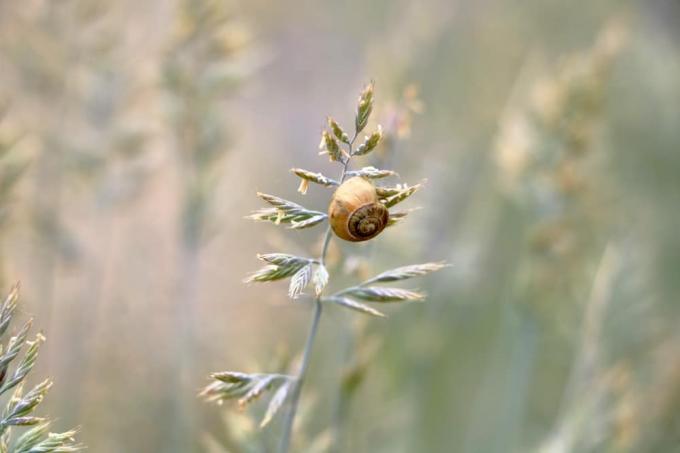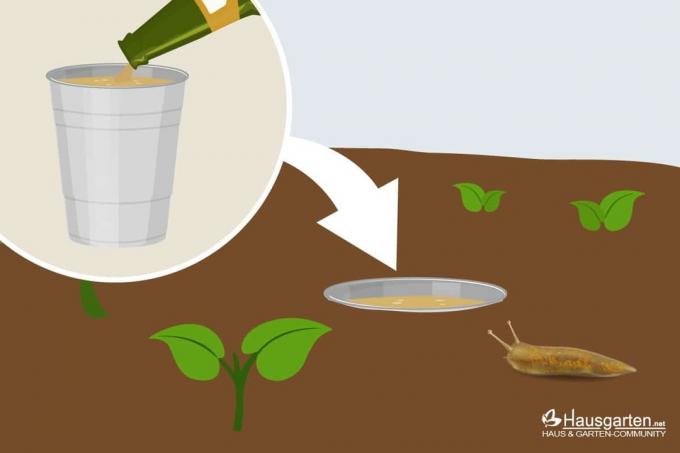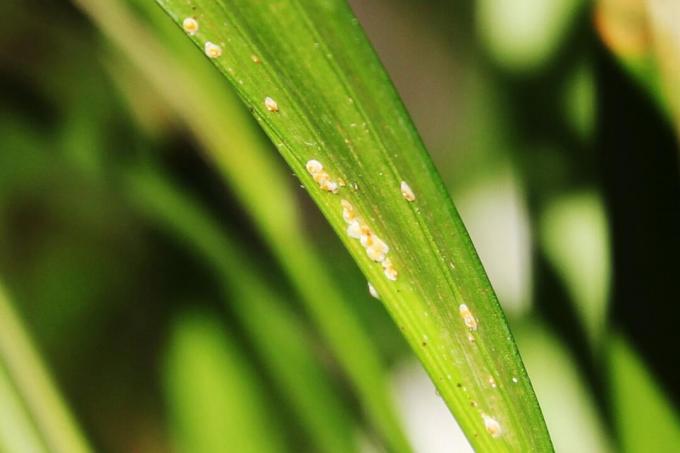

Table of contents
- Prevent snails from growing in the garden
- Use a snail fence to fight snails
- Requirements for a snail fence
- Snail fence must not be overgrown by plants
- Use a metal snail fence
- Install plastic snail fence
- wooden fences
- Install electric fence to control animals
- Build your own fence to fight snails
- Cost of buying in stores
- Fighting snails with home remedies is more effective
Snails in the garden are a nuisance, especially when they become a nuisance and cannot be removed by simply collecting them. They eat the leaves of flowers, vegetables, and shrubs, causing plants to die or have poor yields. A slug fence is one of several natural methods you can use to control slugs.
Prevent snails from growing in the garden
Snails can multiply explosively in the garden and become a real problem for the gardener. A single snail is able to lay around 400 eggs. The filing takes place in autumn. The young animals hatch in the spring. Since snails move very slowly and are therefore unable to find a new habitat, they will settle in your garden. The animals feed mainly on leaves. They can crawl up plants and are thus able to eat entire flowers, vegetables or shrubs. As a result, the plant dies or withers. While a shrub has a chance to recover next year, the summer flower will wither.
Protect your plants by fighting the snails. A fence can be of great service here. You can buy such a fence commercially or you can build it yourself. Metal, in particular copper, or plastic are suitable as materials. If you want to keep the snails out with a fence, there are a few things to consider in both the design and construction.
Use a snail fence to fight snails
If you have removed all the eggs in autumn, the adult animals must be removed the following year. In addition to household remedies such as salt or coffee grounds and chemical snail control agents, you have the option of keeping the animals away from your plants with a fence. You can isolate snails from your plants quite effectively using this method, but if you If you also want to fight animals, you need a means that not only deters the snail, but also destroyed.
Requirements for a snail fence
If you want to install the fence, it must have a special structure. The animals must not be able to climb over the fence and there should also be no loopholes. You can get special snail fences that meet these requirements on the market. When installing, keep in mind that the snails, although slow, are very agile. You manage to climb a fence. For this reason, special requirements are placed on the construction of the fence.
When installing, bring the snail fence about 15 cm deep into the ground. This will prevent the animals from being able to crawl through the fence. Snails burrow into the ground, but they can't get that deep. Therefore, make sure to maintain at least this depth.

The fence has a height of about 10 cm. This prevents the snail from climbing over the fence. The animals will try to climb over the fence. However, they cannot do this because a classic fence is curved on the upper side. It is important that you install the fence with the curved side facing you. So the snail can't get over the fence. She falls back to earth. Since the fence is very low, the snail cannot hurt itself when it falls.
Snail fence must not be overgrown by plants
After installation, it is important that you ensure the fence is free of vegetation. Leaves covering the fence can attract snails. Also, leaves hanging over the fence can defeat the effectiveness of the fence. The snail climbs the plant and thus crawls over the fence. Therefore, always set up the fences completely free and regularly check the vegetation around the fence. This way you make sure that your beds and plants behind the fence are really protected from the snails.
The metal snail fence combines various advantages. It is robust, durable and can remain permanently in the ground. It is also important that the material keeps the snails away. If you use copper, the snails can die if they come into contact with the fence. In this way you achieve a double effect, because you protect your plants and ensure that the animals die if they come into contact with the fence. If you also manage to remove the eggs from your garden in autumn, you can assume that you have overcome the plague. Certainly it will happen that individual animals return. You can then collect these from the plants.
Tip:
Check every fall to see if the animals have laid fresh eggs and carefully remove the feast.
Install plastic snail fence
A plastic snail fence is also able to keep the animals away from your plants. In contrast to metal, however, the material is not harmful to the animals. This means that your plants can still be damaged if the animals manage to climb over the fence. Plastic snail fences have the advantage that they are even more robust than metal fences. For you this means that you can leave the fence in the ground for many years without it rusting or weathering. In addition, the material is very inexpensive.
There are special fences for fighting snails on the market, the height and structure of which are adapted to the needs. However, you can only prevent the animals from getting to your plants with fences made of plastic material. However, the snails will stay alive and you will have to fight the animals differently if you want to get rid of the plague for good.
Tip:
The plastic fence is cheaper to buy, while the metal fence is slightly more effective. You should consider these two aspects before you decide on one of the two materials.
wooden fences
Perhaps you are thinking of installing a wooden fence because it looks more visually appealing. However, this method is not really suitable for snails. The animals can suck themselves perfectly on the wood and climb up the fence. The fence would have lost its effect.
Install electric fence to control animals
An electric fence runs on a battery and gives the animal a mild electric shock that will not kill it. It is effective because the snail cannot climb over the fence. However, the cost is high and the installation effort is large. You need batteries that need to be changed constantly and you need to keep the contacts clean. If they become covered with dirt or moisture gets inside, the effectiveness will be greatly reduced.
Build your own fence to fight snails

With a little craftsmanship, you can build a snail control fence yourself. You will need copper wire, which should be at least five millimeters thick. So it bends well. Observe the height of 30 to 35 cm, sinking 15 cm into the ground. Bend the copper wire in such a way that a finely woven mesh is formed which the animals cannot penetrate. At the top, bend two to four inches to the side at a right angle and install the fence with the bent side facing you. In this way you have made a snail fence very cheaply.
Cost of buying in stores
If you buy a fence in the trade, you will get different variants that differ in design and price. For a metal fence you pay about 30 EUR for ten meters. Plastic fences are slightly cheaper at around EUR 20 for ten meters in length. Alternatively, you can also get metal sheets and transparent walls about ten centimeters high, which the animals cannot climb over.
Fighting snails with home remedies is more effective
If you have to deal with a lot of snails in your garden, a fence can prevent the animals from getting to your plants in the medium term. In this regard, the erection of the fence makes sense in any case. However, it should be a measure that you combine with other measures. If you just put up a fence to control the snails, you will ensure that the animals settle in larger numbers. They stay alive, lay more eggs and the cycle is not broken. For this reason, it is important that you either collect the animals or fight them with home remedies. Lay out salt or coffee grounds in front of the fence. The animals will gather there and die from the home remedies. By combining several measures, you can prevent the snails from spreading further unhindered in your garden.
 garden editorial
garden editorial I write about everything that interests me in my garden.
Learn more about crop protection

Beer trap against snails | Build it yourself or let it be?
There are several ways to banish snails from your garden beds, one of which is the beer trap. The animals smell the yeast contained in the beer and crawl into the trap and are supposed to drown in it. The alcohol in beer is also toxic.

Fight scale insects: 20 home remedies
Scale insects are stubborn and feared pests because they feed on the sap of plants. In addition, they spread rapidly and do not stop at neighboring plants. However, there are various home remedies that you can use to fight the plague.

Build your own snail trap 5 tips for the garden
Snails can cause considerable damage, especially to young plants and new shoots. Building a snail trap yourself can prevent this. But what should be used as bait and how should the snail traps be constructed? We show it here.

Fighting voles in the garden: 14 tips
Controlling voles in the garden can be tedious and frustrating. With the right tools and measures, however, the effort is significantly reduced while the chances of success increase. These can also be biological and gentle so as not to pose a burden on the environment and other animals.

Identify and control clothes moths
Identifying and fighting clothes moths is comparatively easy with the right knowledge. Above all, a nest, eggs or even larvae can be quickly eliminated by appropriate measures. In addition, they can be easily prevented. Our guide shows you how.

Cockroaches in the apartment: where do they come from and what helps?
Cockroaches in the apartment are a horror. The cockroaches are carriers of numerous pathogens and can multiply rapidly within a short period of time. To prevent an infestation, you must know the causes of the settlement or fight the insects.
